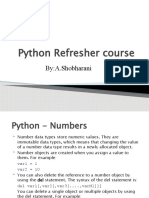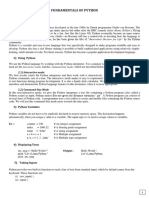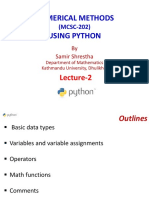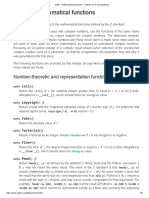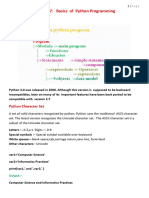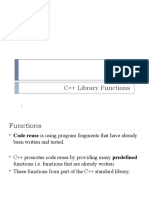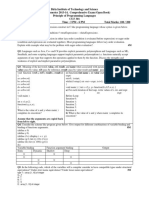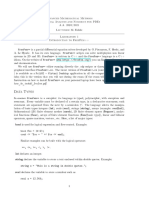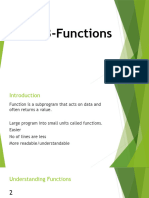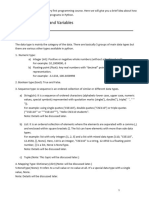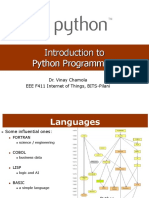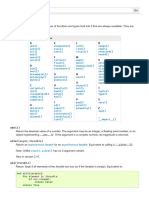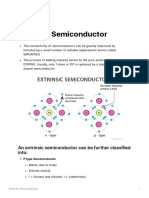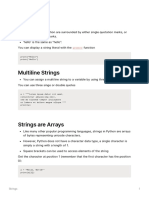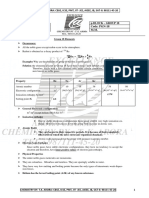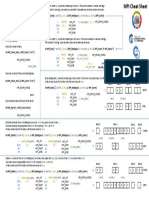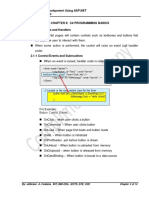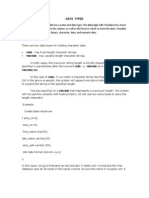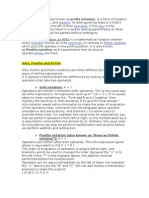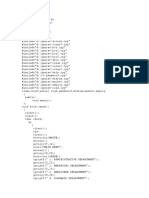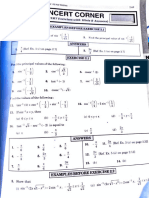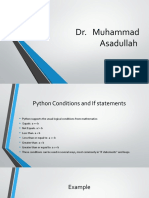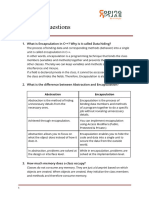Python Revision Tour - Introduction
Python Revision Tour - Introduction
Uploaded by
Ritvik ChaturvediCopyright:
Available Formats
Python Revision Tour - Introduction
Python Revision Tour - Introduction
Uploaded by
Ritvik ChaturvediOriginal Title
Copyright
Available Formats
Share this document
Did you find this document useful?
Is this content inappropriate?
Copyright:
Available Formats
Python Revision Tour - Introduction
Python Revision Tour - Introduction
Uploaded by
Ritvik ChaturvediCopyright:
Available Formats
Python Revision Tour -
introduction
Tokens in Python
1. Keywords
predefined words with special meaning to language compiler or interpreter
cant be used as a normal identifier names
example: False, None, True, and, as, break, elif, if, etc.
2. Identifiers
Names given to different parts of the program viz. variables, objects,
classes, functions, lists, dictionaries.
Rules for Python identifiers
non-keyword word with no spaces in between
made up of only letters, numbers and underscore (_); no symbols
cannot begin with a number
3. Literals/values
String literals:
a sequence of characters surrounded by quotes
can be a multi-line string or single-line string
Numeric literals:
Integer/ int
decimal form: 19, eg, 1234, 6969, 420
octal form: beginning with 0o, 17, eg, 0o35, 0o75
hexadecimal form: beginning with 0x, 19, AF, eg, 079, 0xAF
Float
real numbers with a decimal point
eg, 1.0, 25.0, 203.34
Python Revision Tour - introduction 1
Complex numbers
form a+bi; where i= 1^1/2
Boolean literals
used to represent two values- True or False
Special Literal None
python has one special literal, None
used to indicate the absence of value
4. Operators
tokens which trigger some computation/action when applied to objects
eg. +,<,>,-,/,%, in, not in, =, in, is not, etc.
5. Punctuators
symbols used to organize sentence structures
most common: ' " # / ( ) { } @ : = .
Math Library functions
import math
math.<function name>
(OR)
from math import *
Some math functions
Description
Function
ceil(x) Returns the smallest integer greater than or equal to x.
fabs(x) Returns the absolute value of x
factorial(x) Returns the factorial of x
floor(x) Returns the largest integer less than or equal to x
fmod(x, y) Returns the remainder when x is divided by y
isfinite(x) Returns True if x is neither infinity nor a NaN Not a Number)
isinf(x) Returns True if x is a positive or negative infinity
Python Revision Tour - introduction 2
Description
Function
modf(x) Returns the fractional and integer parts of x
trunc(x) Returns the truncated integer value of x
exp(x) Returns e**x
expm1(x) Returns e**x - 1
log(x[,
Returns the logarithm of x to the base (defaults to e)
base])
log1p(x) Returns the natural logarithm of 1+x
log2(x) Returns the base-2 logarithm of x
log10(x) Returns the base-10 logarithm of x
pow(x, y) Returns x raised to the power y
sqrt(x) Returns the square root of x
acos(x) Returns the arc cosine of x
asin(x) Returns the arc sine of x
atan(x) Returns the arctangent of x
atan2(y, x) Returns atan(y / x)
cos(x) Returns the cosine of x
hypot(x, y) Returns the Euclidean norm, sqrt(x*x + y*y)
sin(x) Returns the sine of x
tan(x) Returns the tangent of x
degrees(x) Converts angle x from radians to degrees
radians(x) Converts angle x from degrees to radians
acosh(x) Returns the inverse hyperbolic cosine of x
asinh(x) Returns the inverse hyperbolic sine of x
atanh(x) Returns the inverse hyperbolic tangent of x
cosh(x) Returns the hyperbolic cosine of x
sinh(x) Returns the hyperbolic cosine of x
tanh(x) Returns the hyperbolic tangent of x
erf(x) Returns the error function at x
erfc(x) Returns the complementary error function at x
gamma(x) Returns the Gamma function at x
Returns the natural logarithm of the absolute value of the Gamma function
lgamma(x)
at x
Python Revision Tour - introduction 3
Description
Function
Mathematical constant, the ratio of the circumference of a circle to its a
pi
diameter 3.14159...)
e mathematical constant e 2.71828...)
Random module
This module implements pseudo-random number generators for various
distributions
import random
random.<function name>
(OR)
from random import *
Some important random functions
Code Notes
Functions
Untitled
Return a randomly selected
Randrange() random.randrange(start, stop[, step]) element from range(start, stop-
1, step)
Return a random integer N such
Randint() random.randint(a, b) that a <= N b. Alias
for randrange(a, b+1.
Return a random element from the
Choice() random.choice(seq) non-empty sequence seq. If seq is
empty, raises IndexError
Return the next random floating
Random() random.random() point number in the range 0.0,
1.0.
link to more random functions: https://docs.python.org/3/library/random.html
Type Conversion
Type Casting/ Explicit type conversion
User-definedtype conversion and thus known as Explicit type conversion
Python Revision Tour - introduction 4
for example,
a=3 ; b=5.0
>>>int(b)
>>>b=5
Type Promotion/ Implicit type conversion
Python automatically converts one data type to another data type. This
process doesn't need any user involvement
for example,
a=3 ; b=5.0
>>>c=a+b
>>>c=8.0 (float)
Looping Statements
3.1 The break statement
terminates the very loop it lies within
skips the rest of the loop and jumps over to the statement following the
loop.
3.2 The continue statement
the continue statement forces the next iteration of the loop to take place,
skipping any code between
Python Revision Tour - introduction 5
You might also like
- Note 3 (Scientific Programming Language) - 1Document22 pagesNote 3 (Scientific Programming Language) - 1olusesiisrael93No ratings yet
- PythonDocument372 pagesPythonMaTi UR ReHmanNo ratings yet
- A2 Python NumbersDocument6 pagesA2 Python Numbersnooraharis2000No ratings yet
- Python Refresher Course: By:A.ShobharaniDocument43 pagesPython Refresher Course: By:A.ShobharaniSridevi Women's Engineering College Department of EIENo ratings yet
- Python Note BookDocument76 pagesPython Note BookShivam DwivediNo ratings yet
- Python FundamentalsDocument4 pagesPython Fundamentalsunknown45No ratings yet
- Numerical Methods Using Python: (MCSC-202)Document29 pagesNumerical Methods Using Python: (MCSC-202)SANJEEV KUMAR KHATRINo ratings yet
- Computer Programming: Furqan AzizDocument30 pagesComputer Programming: Furqan AzizAnees AhmedNo ratings yet
- Tutorial CH 5.1-5.10Document24 pagesTutorial CH 5.1-5.10Hahahhaa rubbishNo ratings yet
- Omparisons: X y Z X y and y Z X yDocument11 pagesOmparisons: X y Z X y and y Z X ylibin_paul_2No ratings yet
- Built in TypesDocument152 pagesBuilt in Typesasher.ak3No ratings yet
- Python 3.7.3 Documentation - Mathematical FunctionsDocument8 pagesPython 3.7.3 Documentation - Mathematical FunctionsankitmaanuNo ratings yet
- Chapter - 3 Python Programming FundamentalsDocument44 pagesChapter - 3 Python Programming FundamentalsNeelima VijayanNo ratings yet
- Matlab CommandsDocument6 pagesMatlab Commandscybermonks222No ratings yet
- Built in FunctionsDocument52 pagesBuilt in Functionsasher.ak3No ratings yet
- Pertemuan 3 - Logika PemrogramanDocument21 pagesPertemuan 3 - Logika PemrogramanARDHIAN DANISWARANo ratings yet
- MATLAB Quick Reference: OperatorsDocument12 pagesMATLAB Quick Reference: OperatorsmanoNo ratings yet
- Basics of Pythhon N OperatorsDocument38 pagesBasics of Pythhon N OperatorsRishu KaulNo ratings yet
- Matlab Quick Reference: Built-In Matrices Logical IndexingDocument2 pagesMatlab Quick Reference: Built-In Matrices Logical Indexingيمين يسارNo ratings yet
- Class XI Ch7Document13 pagesClass XI Ch7Bhavy TamboliNo ratings yet
- Notes Programming UpdatedDocument5 pagesNotes Programming UpdatedShifra Jane PiqueroNo ratings yet
- Python 3.6 Quick Reference SheetDocument2 pagesPython 3.6 Quick Reference SheetTaimoor HassanNo ratings yet
- Topic 5: C++ Library FunctionsDocument19 pagesTopic 5: C++ Library FunctionsCHUN WEN LEENo ratings yet
- EML4930/EML6934: Lecture 01 - About Python: Basics: Data Types, Math, Logic, If StatementDocument35 pagesEML4930/EML6934: Lecture 01 - About Python: Basics: Data Types, Math, Logic, If StatementKingsley Etornam AnkuNo ratings yet
- ITP313 115sDocument23 pagesITP313 115sJay Neri AnonuevoNo ratings yet
- Essential Python Cheat Sheet: SschaubDocument11 pagesEssential Python Cheat Sheet: SschaubOusmane Diamari100% (1)
- Type T Array (1..10) of Integer S T A: T B: T C: S D: Array (1..10) of IntegerDocument3 pagesType T Array (1..10) of Integer S T A: T B: T C: S D: Array (1..10) of IntegerRishab JainNo ratings yet
- Python UNIT-1Document15 pagesPython UNIT-1satya narayanaNo ratings yet
- Function NotesDocument11 pagesFunction NotesBhaskar JhaNo ratings yet
- Unit 3 (Recursion, Higher Order Function and String)Document16 pagesUnit 3 (Recursion, Higher Order Function and String)Abhishek Kumar YadavNo ratings yet
- Built-In Functions - Python 3.10.1 DocumentationDocument27 pagesBuilt-In Functions - Python 3.10.1 Documentationturkey breadNo ratings yet
- Cheat SheetDocument2 pagesCheat SheetCmpt CmptNo ratings yet
- Question Bank With AnswersDocument49 pagesQuestion Bank With Answerschandannaik7892210426No ratings yet
- LAB#2 Implementation of Constants, Variables and ExpressionsDocument6 pagesLAB#2 Implementation of Constants, Variables and ExpressionskhawarNo ratings yet
- Python ModulesDocument29 pagesPython ModulesmNo ratings yet
- Mathematical Functions: Number-Theoretic and Representation FunctionsDocument11 pagesMathematical Functions: Number-Theoretic and Representation FunctionsNikita AgrawalNo ratings yet
- Functions in PythonDocument52 pagesFunctions in PythonRaviraj kundekarNo ratings yet
- FCHGCDocument13 pagesFCHGCEliot KhNo ratings yet
- PythonQuickReference PDFDocument54 pagesPythonQuickReference PDFHa Dinh Thanh100% (1)
- Functions: Aryaf AladwanDocument70 pagesFunctions: Aryaf Aladwansaeed wedyanNo ratings yet
- Computer Programming (M4-Main) PDFDocument44 pagesComputer Programming (M4-Main) PDFMohamad LajaratoNo ratings yet
- Python BasicsDocument35 pagesPython Basicssumanthcm.cseNo ratings yet
- 7 - String Analysis PDFDocument116 pages7 - String Analysis PDFArdit MelishteNo ratings yet
- Library Functions - PracticeDocument53 pagesLibrary Functions - PracticeTejasvini YadavNo ratings yet
- Operators and Expression - StudentDocument47 pagesOperators and Expression - StudentlineshNo ratings yet
- Application Based Programming in Python Chapter 2Document13 pagesApplication Based Programming in Python Chapter 2Womba LukamaNo ratings yet
- Functions (ch3)Document59 pagesFunctions (ch3)rithanvijayakumar27477No ratings yet
- Built-In Functions - Python 3.9.0 DocumentationDocument29 pagesBuilt-In Functions - Python 3.9.0 DocumentationjandraqNo ratings yet
- Beginners' Python: Based On Presented byDocument66 pagesBeginners' Python: Based On Presented byharutyunNo ratings yet
- Abc DDocument60 pagesAbc DMurtadho 108No ratings yet
- Manual of PythonDocument43 pagesManual of PythonSatya vir singh raghavNo ratings yet
- C++ Header Files and Standard Functions: Assert. You Use Assertwrites An Error Assert #Define NDEBUGDocument5 pagesC++ Header Files and Standard Functions: Assert. You Use Assertwrites An Error Assert #Define NDEBUGmaxdimaztrialNo ratings yet
- 01 Python BasicsDocument19 pages01 Python BasicsshahriaralomadibNo ratings yet
- Python - Iot PDFDocument50 pagesPython - Iot PDFNIKHIL ARORANo ratings yet
- Built-In Functions - Python 3.11.2 DocumentationDocument26 pagesBuilt-In Functions - Python 3.11.2 Documentationprofessional.ca728No ratings yet
- Part 3Document5 pagesPart 3AshokNo ratings yet
- (PPT) Introduction To The Python Programming LanguageDocument36 pages(PPT) Introduction To The Python Programming LanguagecreatethreadNo ratings yet
- Extrinsic Semiconductor: An Extrinsic Semiconductor Can Be Further Classified IntoDocument2 pagesExtrinsic Semiconductor: An Extrinsic Semiconductor Can Be Further Classified IntoRitvik ChaturvediNo ratings yet
- StringsDocument7 pagesStringsRitvik ChaturvediNo ratings yet
- The HolocaustDocument4 pagesThe HolocaustRitvik ChaturvediNo ratings yet
- Group 18 Class 12 NotesDocument4 pagesGroup 18 Class 12 NotesRitvik Chaturvedi100% (1)
- MPI Cheat SheetDocument1 pageMPI Cheat SheetLUCIAN VOINICANo ratings yet
- Java 2301Document30 pagesJava 2301Thalapathy Raj KamalNo ratings yet
- 1.2 Auxillium 2022Document68 pages1.2 Auxillium 2022杨俊熙(Stanley)No ratings yet
- Bca (2 Sem)Document4 pagesBca (2 Sem)bhansurya384No ratings yet
- x86 64 psABI 1.0 PDFDocument157 pagesx86 64 psABI 1.0 PDFImanol-Mikel Barba SabariegoNo ratings yet
- Object Oriented Thinking: AsfarDocument63 pagesObject Oriented Thinking: AsfarAshar KizakiNo ratings yet
- C# Interview Question PDFDocument26 pagesC# Interview Question PDFshreyasgudupiNo ratings yet
- 02 C#ProgrammingBasicsDocument14 pages02 C#ProgrammingBasicsJefferson Abrea CostalesNo ratings yet
- C Language Aptitude Test Paper by Placementpapers - Net 1Document54 pagesC Language Aptitude Test Paper by Placementpapers - Net 1amit_aec_8291No ratings yet
- Unit 4 C Prog PDFDocument7 pagesUnit 4 C Prog PDFRIT BCANo ratings yet
- Classes and Structs in C++: Based On Materials by Bjarne StroustrupDocument29 pagesClasses and Structs in C++: Based On Materials by Bjarne Stroustrupjohn albert100% (1)
- Constructor and DestructorDocument31 pagesConstructor and Destructorashema compSci100% (3)
- Data TypesDocument4 pagesData TypesVicky VigneshNo ratings yet
- Quick RevisionDocument28 pagesQuick RevisionKrish PatelNo ratings yet
- Logic Arithmetic Algebra Operators Operands ArityDocument5 pagesLogic Arithmetic Algebra Operators Operands ArityPia GuhaNo ratings yet
- Coding On Travel Management in C++Document213 pagesCoding On Travel Management in C++999073757850% (12)
- Static and Dynamic CallDocument19 pagesStatic and Dynamic CallThrinadh Kiran KumarNo ratings yet
- Specifications: Class Class From To ConstructorDocument3 pagesSpecifications: Class Class From To ConstructorDebanik Majumder33% (6)
- 02 StacksDocument32 pages02 Stacksamitfegade121No ratings yet
- Chapter-4 (3) Function Overriding, Member Classes Nesting of ClassesDocument25 pagesChapter-4 (3) Function Overriding, Member Classes Nesting of ClassesSKMNo ratings yet
- Core Java AdvancedDocument103 pagesCore Java AdvancedRavi Chandra Reddy MuliNo ratings yet
- Inverse Trigonometric Functions NCERTDocument5 pagesInverse Trigonometric Functions NCERTharshahlawat653No ratings yet
- C# - Loops: Loop Control StatementsDocument2 pagesC# - Loops: Loop Control Statementspbc3199No ratings yet
- Exercise: Create A Function Named Myfunction and Call It Inside MainDocument8 pagesExercise: Create A Function Named Myfunction and Call It Inside MainJhay El GambaNo ratings yet
- Compiler Design LabDocument49 pagesCompiler Design Labudayalugolu6363No ratings yet
- If Else and LoopsDocument29 pagesIf Else and LoopsSyed Kamran Ahmad1No ratings yet
- CprogrammingwithansDocument34 pagesCprogrammingwithansgohigol953No ratings yet
- GP OOPS C++ Encapsulation InterviewDocument3 pagesGP OOPS C++ Encapsulation Interviewarnesh dadhichNo ratings yet
- Unit 3Document20 pagesUnit 3pranav.2226ec1106No ratings yet
- 17.set in PythonDocument6 pages17.set in Pythondnyaneshwar patilNo ratings yet




